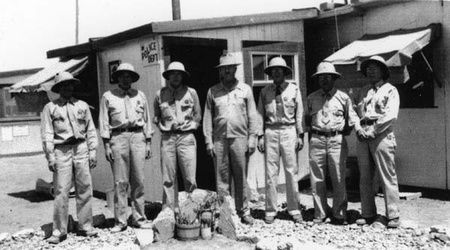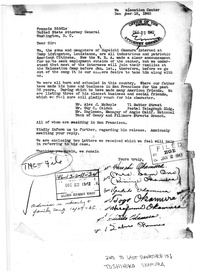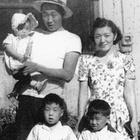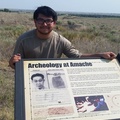Read Part 1 >>
In 2003, in response to a request I’d submitted to the National Archives in Washington, DC for documentation relating to my grandfather’s arrest and imprisonment by the FBI, INS and the DOJ during WWII, I received well-over 190-copy pages of records from his personal file, which included a filled-out 28-page “U.S. Department of Justice, Alien Enemy Questionnaire.” I learned that he was in: Fort Missoula, Montana; Fort Sill, Oklahoma; Camp Livingston, Louisiana; Lordsburg, New Mexico and ended-up at the Santa Fe, New Mexico Detention Center.
Much to my surprise and delight, among these documents were typed and handwritten letters from all the members of my grandfather’s immediate family, Bachan, their seven children and daughter-in-law Dorothy Yoshiko (Kato) Okamura, all pleading for his release! Rather than just a dry collection of impersonal formal government forms, reports, and memos regarding his arrest, requests, hearings, transfers, and imprisonment, here were direct personal evidences of a concerned family’s drama that was played-out. These were the “letters from camp!”
According to an INS Change of Status Report (19411219), Jichan left 801 Silver Aveue, San Francisco by train and arrived at winter-frozen Ft. Missoula Detention Camp, Montana on December 23, 1942, two-days before Christmas! Can you imagine the extra layer of melancholy that must have weighed-down on his and the other prisoners’ spirit at that time of the year?
Don’t know, but hopefully Jichan didn’t have to face some of the documented abuses and harsh treatments experienced by other Ft. Missoula prisoners? In his book, “My Six Years of Internment,” the late Reverend Yoshiaki Fukuda, the revered founder of the Konkokyo Church in San Francisco reported that “immigration officers conducted extensive investigations to determine if any of us entered this country illegally. Mr. Kubota of San Pedro came under suspicion of being an illegal alien and was isolated in a small dark cell for over a month. Without toilet facilities, he had to defecate and urinate on the floor. He was harshly interrogated almost daily and even had several of his teeth broken. Consequently, he almost went insane.”
Jichan was in Ft. Missoula at that time. He must have heard about Kubota’s plight and I imagine it must have struck fear in him as well as in his fellow inmates. In his book, Professor Tetsuden Kashima described many other abuse incidents in other U.S. Army, DOJ, INS and WRA facilities and even some killings of these wartime inmates. Kashima also noted some of the protest and resistance these vulnerable, but brave Isseis mounted.

Suyeichi Okamura, 2nd from left, front row is shown in the Santa Fe, New Mexico Detention Camp, where he ended up after a series of four moves after Missoula, Montana for which there were no reasons given.
Before facing a hearing board to determine their future fate, they all were required to fill-out the “Alien Enemy Questionnaire.” The hearing process was supposedly an opportunity to make a case for their innocence, although, they were already arrested, transported and imprisoned as guilty of being dangerous Alien Enemies in a prison camp in Missoula, Montana. Conversely, they were not “innocent until proven guilty.” (see 19420209a & b) Hearing board’s recommendation that he be kept Interned (imprisoned).
The first of the “letters from camp” was actually not sent from Amache, but from the Merced Assembly Center (MAC). The MAC was one of (13) holding-camps hastily set-up in fairgrounds, racetracks and public facilities throughout California. There were also an assembly center each in the states of Washington and Oregon - Puyallup and Portland respectively. Arizona had (2), Mayer and Parker Dam. The (17) assembly centers were chosen and readied to hasten the removal of Japanese from their homes, farms and places of businesses. This haste was rationalized as military necessity and to hold them in stockades while more permanent camps were being fabricated, and as referenced earlier, in less than desirable locations. Most were in areas of extreme weather especially consequential considering these prisoners, grandparents, parents and children, had to live in cheaply-built barracks.
The first letter, Bachan’s, dated August 17, 1942, (19420817), was sent one month before the family was put on trains for Granada, Colorado. It was typed and addressed to Division of Immigration, Department of Justice in Washington D.C. and signed by Mrs. Owai Okamura. I surmise that my father, Sam Masami Ono, might have composed and typed it for her. It reads like his business-style. He was a volunteer in the MAC police force and probably had access to a typewriter. Sam Masami Ono is second from left in this 1942 photograph of MAC police officers.
Basically, Bachan was asking for her husband, Suyeichi to be released from Camp Livingston, Louisiana, the first Internment camp he was assigned to after being in Fort Missoula, Montana. She desperately wanted him to join the family as they were slated to be moved from the Merced Assembly Center to the Granada Relocation Center in Colorado. As stated in her letter, her husband should join the family in Colorado because, “We shall be well out of the real strategic area defined by the Western Defense Command and the Fourth Army.” Also, the letter lists three other reasons: 1. that their seven children are all born in the America and are US citizens, 2. that he has operated his confectionary business responsibly for 40-years, and 3. that one of his daughters has recently been very ill and wished her father to join them.
In a memo from W.F. Kelley (19420829), a Border Patrol Supervisor, INS to Edward J. Ennis, Director of Alien Enemy Control Unit regarding my grandmother’s letter (19420817) states, “As far as his file shows, her husband is still in Fort Sill, Oklahoma where he has been since May, 1942 and so, there is no reply to her letter.” Can you imagine the confusion and the anxiety that that response must have set-off?
I don’t have the space or time to show each letter by each sibling over the course of two-years, from the youngest eleven-year-old Tom Togo to the eldest son, Hiroshi, 27, but right is an appeal letter (19421218, right) to the U.S. Attorney General, Francis Biddle that is very striking because it is signed by all seven of his children’s!
The seven Okamura siblings are shown below in Amache save for No.4, Uncle George Saburo, who in this photo was in Camp Savage, Minneapolis in the MIS Language School. The numbers are directly beneath each sibling according to their age order and are pictured with various family members or in the case of No. 7, Uncle Tom Togo shown with fellow Boy Scouts. 1- Hiroshi, 2- Kimiye Ono, 3- Yukiko Masuoka, 4- George Saburo, 5- Hirofumi “Hippo”, 6- Toshihiko, Amache Indians basketball star, and 7- Tom Togo.
*All photos are courtesy of Gary Ono.
© 2011 Gary Ono










